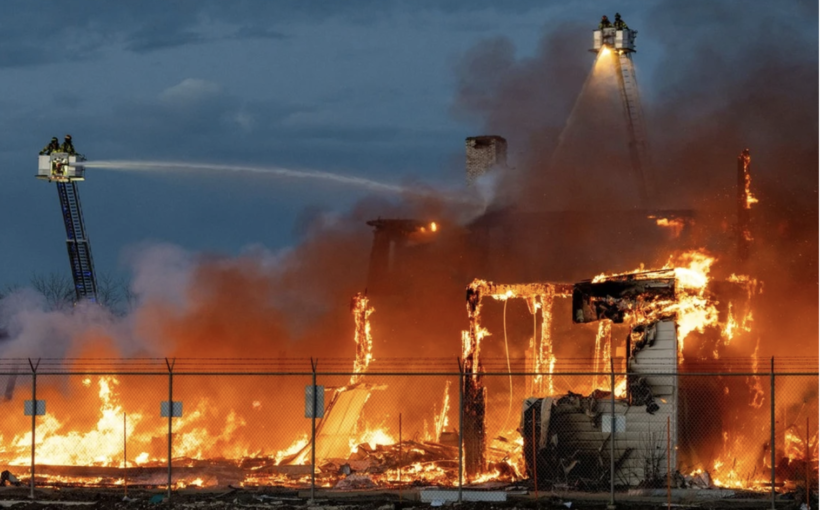Big in scale and historic significance, the Second World War building that went down in flames a week ago involved some huge commitments, leaving owners and City of Edmonton officials scrambling for what comes next.
On June 28, 2021, Architure Inc. and Tim Antoniuk struck a deal to buy the three-acre Hangar 11 property for $1.5 million — less than half its assessed value of $3.8 million on the tax rolls.
It was an unconventional deal — but the aging hangar was a diamond in the rough.
The goal was a mixed-use “live, work, eat, play development” that could house 225 student residences and commercial space, with rooftop gardens and a connection to the adjacent Blatchford neighbourhood development’s energy system.
That was expected to take at least $75 million.
“That building was sitting derelict for 20 years and nobody had been living in it. It was in terrible condition,” said David Johnston, principal heritage planner for the City of Edmonton.
A hazardous materials assessment done in 2017 revealed few surprises for a building of that era.
“There was asbestos in the building, for things like pipe insulation, drywall, grout, some floor tiles — the sort of standard materials from a building constructed in that era,” he said.
“Also things like lead paint. The baseboards and doors had original paint on them and things like that.”
The city’s promised $5 million over 10 years to help with the project wouldn’t have applied to remediating hazardous materials. Remediation hadn’t been initiated prior to the fire, Johnston said.
Even if there had been a wired-in smoke alarm, there was no power (or water) services active at the property, Johnston said. Edmonton city police have deemed the fire that razed the hangar “suspicious” in nature.
Agreement in place
The proposal for the upgrade and revival of Hangar 11 resulted in a sale at less-than-market value.
That required a number of conditions, including advertising it over two weeks, and a rehabilitation incentive and maintenance agreement with designation as a municipal historic resource.
An accompanying financial and corporate services report would have been approved by the city manager, and remain private pursuant to section 27 (privileged information) of the Freedom of Information and Protection of Privacy Act.
The transaction was said to align with the city plan’s Big City Move: A Rebuildable City.
The condition required advertising the proposed sale in the Edmonton Journal on April 14, 2021, and April 21, 2021.
The city weighed the expedited sale against the odds of the sale value declining if it fell into further disrepair, gauged overall at moderate risk.
The city agreed to complete basic leak protection work on key sections of the building to “prevent further damage.”
Hanging onto the building risked losing the historic resource and potential demolition, the city found.
Avoided capital investment risk included basic building stabilization — gauged at between $18 million and $27 million, and bringing the building to “a leasable standard,” including historic conservation, estimated between $55 million and $83 million.
The Hangar 11 project’s $5-million grant was an exception to the current practice of the program, which currently limits non-residential properties to a maximum total grant of $500,000 for rehabilitation work up to 50 per cent of eligible costs from the tax-funded heritage resources reserve.
The city had previous success with a similar large grant for the Molson Brewery project, a masonry building now in the last two years of its $4-million-plus grant.
“We haven’t paid any of that (Hangar 11) money out to date. There hadn’t been any actual rehabilitation work undertaken on the structure prior to the fire, other than design work and architecture work done and things like that, but there hadn’t been any actual historic rehabilitation work undertaken,” Johnston said in a recent interview.
The site had been rezoned by city council to accommodate the intended redevelopment of the building, and permits had been issued for the changes and alterations.
There were no discussions with Hangar 11’s new owners about any changes or extensions to plans, Johnston said.
Clean up and what’s next
Almost three years after the agreement was struck, Hangar 11 finally changed hands, just two weeks before the hangar burned down. Clean-up will be the responsibility of the owner and their insurance.
“As far as I’m aware, they’re starting to get mobilized on looking at how that will be done,” Johnston said.
“There’s a lot of uncertainty at the moment. There’s a lot of legal aspects to what’s going to be happening and our objective will be there to just assist the owners as best we can.
“It’s a huge loss. They’re reeling still, we’re still reeling ourselves.
“Literally the dust needs to settle a bit before we can start kind of wrapping our heads around it,” he said.
“Our hope is that we’ll just be there to assist the owners with making their decisions — and they’ve got a lot of difficult decisions on the horizon,” he said.
Calls from Postmedia to Hangar 11 owner Tim Antoniuk weren’t returned by press time.




